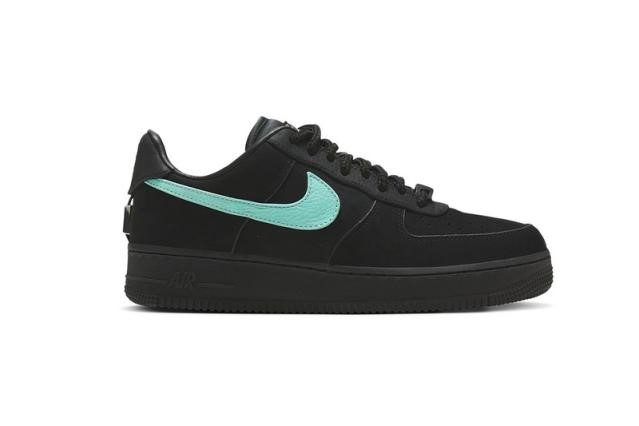[vc_row][vc_column][vc_column_text dp_text_size=”size-4″]Last night, the NBA released an Instagram video showing LeBron James walking underneath Madison Square Garden fully decked out in pieces from the new Tiffany & Co x Nike collaboration that won’t drop till March 7. He wore a black letterman jacket with slick leather sleeves, featuring lots of Tiffany branding in its easily identifiable blue color. To finish off the look, he donned the unreleased Tiffany & Co x Air Force 1 sneakers, featuring a robin’s-egg blue swoosh, that will retail for $400. Nike says that the launch will also include limited-edition sterling silver shoe accessories, including a shoe horn and shoe brush that will be priced between $250 and $475.
Collaborations are a fairly new strategy for Tiffany that began when French luxury conglomerate LVMH acquired the 186-year-old American jeweler in January 2021. At that time, 30-year-old Alexandre Arnault—the son of LVMH’s founder and CEO—became Tiffany’s executive vice president of product and communication. Arnault has spearheaded the steady stream of collaborations that have come out of Tiffany since. Some have been with other luxury brands, like Fendi and watchmaker Patek Philippe, but also with streetwear brand Supreme and artist Daniel Arsham. The company has created Tiffany blue basketballs and footballs with Wilson.
Tiffany’s first cooperation with a mass market corporation, Nike, will enable the company to connect with a wider range of youthful consumers. This makes the Nike connection noteworthy. As with many collaborations, the aim is to revitalise an aged legacy brand. Despite the fact that the fashion business is overrun by brand alliances, Arnault seems to understand what makes a relationship stand out. He states, “We’re attempting, bit by little, to leverage all Tiffany has done over the last 200 years as the sole American luxury brand, and bring it into the present, making it part of cultural zeitgeist.”
This isn’t a new strategy for Arnault, who tapped his collaboration playbook when he became the CEO of the German suitcase company Rimowa in 2016, after LVMH acquired it. Rimowa partnered with everyone from Louis Vuitton to Supreme to Off-White. The company also teamed up with smaller, independent artists and labels, like the French label NASASEASONS and the Japanese brand United Arrows.
Arnault believes constant novelty and creativity is crucial to the success of modern luxury brands. “You need to be a part of the cultural conversation,” he says. “I feel like Tiffany wasn’t part of the conversation over the past few years.” One of the first things he did when he joined Tiffany was to build a team that was able to react quickly to what was happening in culture and find ways to engage. This has involved launching campaigns with the likes of Beyoncé and Jay-Z , and collaborating with other artists and brands.
The fashion business has relied heavily on collaborations for the past ten years. Initially, they were more uncommon and notable, but with time, brands have produced them at a faster rate. Partnerships between Gucci and Adidas, Burberry and Supreme, Dior and Birkenstock, and Jacquemus and Nike are anticipated in 2023. Collaborations are losing their impact because they are so ubiquitous, according to Kayla Marci, an analyst at the fashion analysis firm Edited. According to her study, collabs generally sell out more slowly than solo projects. Over time, their worth on the secondary market has likewise decreased.
But that doesn’t mean collaborations aren’t worth doing, Marci adds. Partnerships can be very valuable because they tap into another brand’s audience. She points out that many brands, like Converse, drop collaborations every few weeks. The Converse collaboration with Comme Des Garcons in 2009 was so successful that the brands regularly put out new styles. “For some brands, collaborations are just a part of the core product strategy,” she says.
But even in a crowded landscape of collaborations, it’s possible for certain partnerships to stand out. Part of the reason the Tiffany & Co. x Nike collaboration works so well, Marci says, is that it’s unexpected. “It was an out of the box move for Tiffany, especially considering its history,” she says. “The brand is so associated with diamonds and jewelry. This positions it clearly in the fashion category.” She says this also has the potential to expand Tiffany’s product range into shoes and clothing, even after this particular collaboration passes.
Due of the disparity in target markets and price points between Tiffany and Nike, the cooperation is also unexpected. Given that Tiffany jewellery typically costs thousands of dollars, the items in this collection—including the sneaker—will be reasonably priced at $250 to $475. Marci, though, thinks Tiffany will be able to attract a younger clientele. She claims that Nike appeals to Gen Z shoppers. Additionally, the combination combines two instantly recognisable and powerful icons, Tiffany blue and the Nike Swoosh.
Arnault is establishing himself as the pioneer of a new era of luxury products with his distinctive approach to collaboration. In the past, high-end fashion houses were wary of collaborating with mass-market brands for concern that it would weaken their brand. In order to maintain the air of exclusivity, many people also tended to be conservative in their marketing strategies. But Arnault isn’t worried about this. He declares, “I worry about companies that are too pure and irrelevant. It’s a fine line to walk, for sure. However, after you get the hang of it, you may talk to a variety of clients, from the expensive jewellery buyer to her grandchild.
[/vc_column_text][/vc_column][/vc_row]











